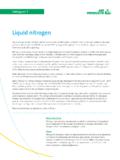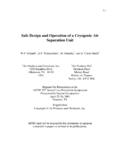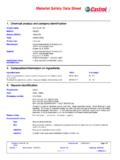Transcription of SAFETY DATA SHEET - Priority Care
1 SAFETY data SHEET Chlorhexidine Scrub 2% First Priority , Inc. Page 1 of 7 Prepared to OSHA, CMA, ANSI, Canadian WHMIS Standards, Australian WorkSafe, Japanese Industrial Standard JIS Z 7250:2000, and European Directives 1. PRODUCT IDENTIFICATION TRADE NAME (AS LABELED): Chlorhexidine Scrub 2% SYNONYMS: Not available CAS#: Mixture PRODUCT USE: Antimicrobial CHEMICAL SHIPPING NAME/CLASS: Not-Regulated NUMBER: N/A MANUFACTURER'S NAME: First Priority , Inc. ADDRESS: 1590 Todd Farm Drive, Elgin, IL 60123-1287 BUSINESS PHONE: 800-650-4899 EMERGENCY PHONE: 800-424-9300 (Chemtrec 24 Hrs) WEB SITE: DATE OF CURRENT REVISION: July 6, 2015 DATE OF LAST REVISION: New 2.
2 HAZARD IDENTIFICATION EMERGENCY OVERVIEW: This product is a clear green liquid with a pleasant odor. Health Hazards: Contact with the eye may cause damage. May cause skin irritation. Flammability Hazards: This product is a non-combustible liquid with a flash point of >200 F (93 C) Reactivity Hazards: None known Environmental Hazards: Release of this product may have adverse effects in the aquatic environment. US DOT SYMBOLS CANADA (WHMIS) SYMBOLS EUROPEAN and (GHS) Hazard Symbols Not Regulated Complies with WHMIS 2015 Signal Word: Danger! GHS LABELING AND CLASSIFICATION: CLASSIFICATION OF SUBSTANCE OR MIXTURE IN ACCORDANCE WITH 29 CFR 1200 (OSHA HCS) AND THE EUROPEAN UNION DIRECTIVES: This product does meet the definition of a hazardous substance or preparation as defined by 29 CFR 1910.
3 1200 AND the European Union Council Directives 67/548/EEC, 1999/45/EC, 1272/2008/EC and subsequent Directives. EU HAZARD CLASSIFICATION OF INGREDIENTS PER DIRECTIVE 1272/2008/EC: Index Number: EC# 231-791-2 This substance is not classified in the Annex VI of Directive 67/548/EEC EC# 216-700-6 This substance is not classified in the Annex VI of Directive 67/548/EEC EC# 242-354-0 This substance is not classified in the Annex VI of Directive 67/548/EEC CAS# 68439-46-3 is not listed in ESIS Substances not listed either individually or in group entries must be self classified. Component(s) Contributing to Classification(s) All Ingredients LABEL ELEMENTS: GHS Hazard Classification(s): Eye Damage Category 1 Skin Irritation Category 2 Aquatic Acute Category 2 Hazard Statement(s): H318: Causes serious eye damage H315: Causes skin irritation H401: Toxic to aquatic life SAFETY data SHEET Chlorhexidine Scrub 2% First Priority , Inc.
4 Page 2 of 7 Precautionary Statement(s): P264: Wash thoroughly after handling. P280: Wear gloves and eye protection / face protection. P273: Avoid release to the environment. HEALTH HAZARDS OR RISKS FROM EXPOSURE: SYMPTOMS OF OVEREXPOSURE BY ROUTE OF EXPOSURE: The most significant routes of overexposure for this product are by contact with skin or eyes, inhalation and ingestion. The symptoms of overexposure are described below: ACUTE: INHALATION: Inhalation of mist or spray may cause respiratory irritation. CONTACT WITH SKIN: Contact with the skin may cause irritation. EYE CONTACT: Contact may cause serious eye, cornea damage. INGESTION: Under normal conditions of intended use, this material is not expected to be an ingestion hazard.
5 Ingestion may cause gastrointestinal irritation, nausea and vomiting. CHRONIC: Prolonged contact with skin may cause defatting and dermatitis. TARGET ORGANS: Acute: Eyes, Skin, Respiratory tract Chronic: Skin 3. COMPOSITION AND INFORMATION ON INGREDIENTS Hazardous Ingredients: WT% CAS# EINECS # GHS Hazard Classification Water 60 - 72% 7732-18-5 231-791-2 Not Classified Ammonyx LO 10 - 20% 1643-20-5 216-700-6 H314 Skin Irrit Cat 2, H318 Serious Eye Dam Cat 1, Aquatic Acute Cat 1 Chlorhexidine Gluconate 2 - 3% 18472-51-0 242-354-0 H318 Serious Eye Dam Cat 1, Aquatic Acute Cat 1 Alcohols C9-C11 Ethoxylated 1 - 5% 68439-46-3 Not Listed H302 Acute Tox Cat 4, H318 Serious Eye Dam Cat 1 Balance of other ingredients is less than 1% in concentration (or for carcinogens, reproductive toxins, or respiratory sensitizers).
6 NOTE: This product has been classified in accordance with the hazard criteria of the CFR and the SDS contains all the information required by the CFR, EU Directives and the Japanese Industrial Standard JIS Z 7250: 2000. 4. FIRST-AID MEASURES DESCRIPTION OF FIRST AID MEASURES: EYE CONTACT: If product enters the eyes, open eyes while under gentle running water for at least 15 minutes. Seek medical attention if irritation persists or blurred vision occurs. SKIN CONTACT: Wash skin thoroughly with soap and water after handling. Seek medical attention if irritation develops and persists. INHALATION: If breathing becomes difficult, remove victim to fresh air. If necessary, use artificial respiration to support vital functions.
7 Seek medical attention. INGESTION: If product is swallowed, call physician or poison control center for most current information. If professional advice is not available, do not induce vomiting. Never induce vomiting or give diluents (milk or water) to someone who is unconscious, having convulsions, or who cannot swallow. Seek medical advice. Take a copy of the label and/or SDS with the victim to the health professional. MEDICAL CONDITIONS AGGRAVATED BY EXPOSURE: Some individuals may develop skin sensitization from exposure. SYMPTOMS AND EFFECTS, BOTH ACUTE AND DELAYED: Contact with eyes may cause blurriness and damage to cornea. Contact with skin may cause irritation. RECOMMENDATIONS TO PHYSICIANS: Treat symptoms and eliminate overexposure.
8 5. FIRE-FIGHTING MEASURES FIRE EXTINGUISHING MATERIALS: FIRE EXTINGUISHING MATERIALS: Use fire extinguishing methods below: Water Spray: Yes Carbon Dioxide: Yes Foam: Yes Dry Chemical: Yes Halon: Yes Other: Any C Class SAFETY data SHEET Chlorhexidine Scrub 2% First Priority , Inc. Page 3 of 7 UNUSUAL FIRE AND EXPLOSION HAZARDS: This product is a non-combustible liquid with a flash point > 200 F (93 C). Explosion Sensitivity to Mechanical Impact: No Explosion Sensitivity to Static Discharge: No SPECIAL FIRE-FIGHTING PROCEDURES: Incipient fire responders should wear eye protection. Structural firefighters must wear Self-Contained Breathing Apparatus and full protective equipment.
9 Isolate materials not yet involved in the fire and protect personnel. Move containers from fire area if this can be done without risk; otherwise, cool with carefully applied water spray. If possible, prevent runoff water from entering storm drains, bodies of water, or other environmentally sensitive areas. NFPA RATING SYSTEM HMIS RATING SYSTEM HAZARDOUS MATERIAL IDENTIFICATION SYSTEM Flammability HEALTH HAZARD (BLUE) 2 FLAMMABILITY HAZARD (RED) 0 Health Reactivity PHYSICAL HAZARD (YELLOW) 0 PROTECTIVE EQUIPMENT EYES RESPIRATORY HANDS BODY Other See Sect 8 See Sect 8 For Routine Industrial Use and Handling Applications Hazard Scale: 0 = Minimal 1 = Slight 2 = Moderate 3 = Serious 4 = Severe * = Chronic hazard 6.
10 ACCIDENTAL RELEASE MEASURES PERSONAL PRECAUTIONS, PROTECTIVE EQUIPMENT AND EMERGENCY PROCEDURES: Use cautious judgment when cleaning up spill. Wear suitable protective clothing, gloves, and eye/face protection. ENVIRONMENTAL PRECAUTIONS: Stop leak. Contain spill if possible and safe to do so. Prevent product from entering drains. SPILL AND LEAK RESPONSE: Stop the flow of material, if this can be done safely. Dike and contain the spill with inert material (sand, earth, fuller's earth, etc.) and if appropriate, transfer the liquid and solid diking material to containers for disposal. Remove contaminated clothing promptly and wash affected skin areas with soap and water. Wash clothing before reuse. Keep spill out of all sewers and open bodies of water.


